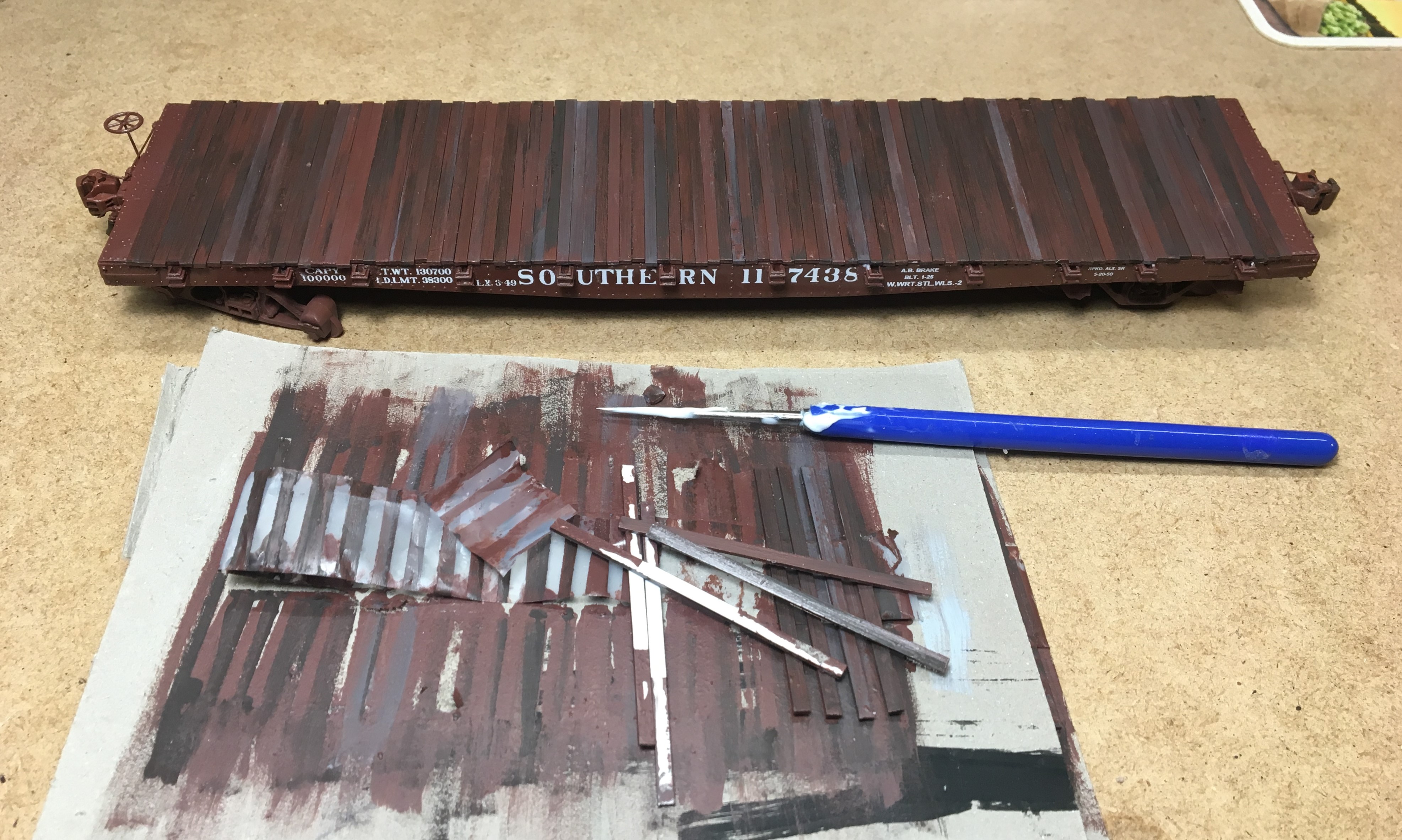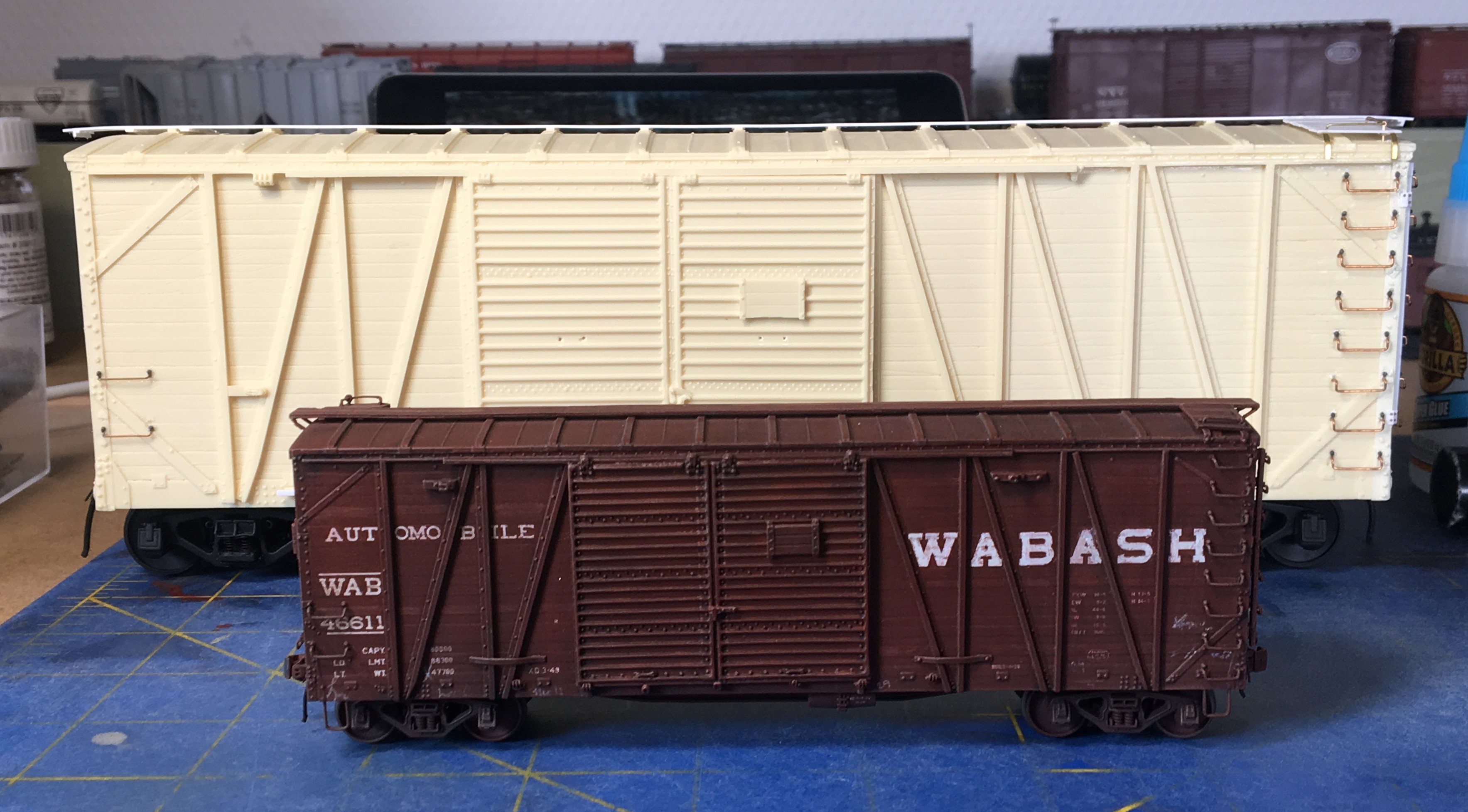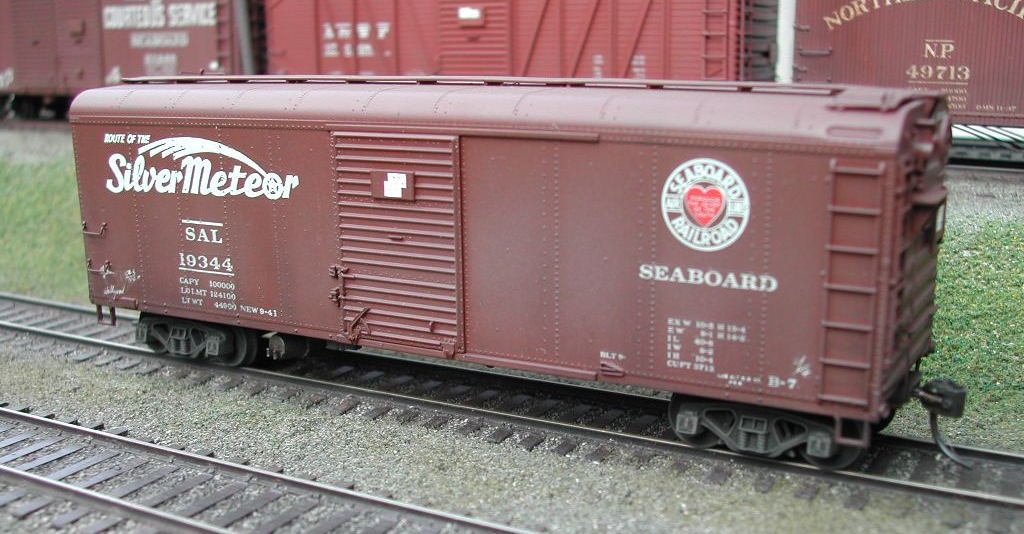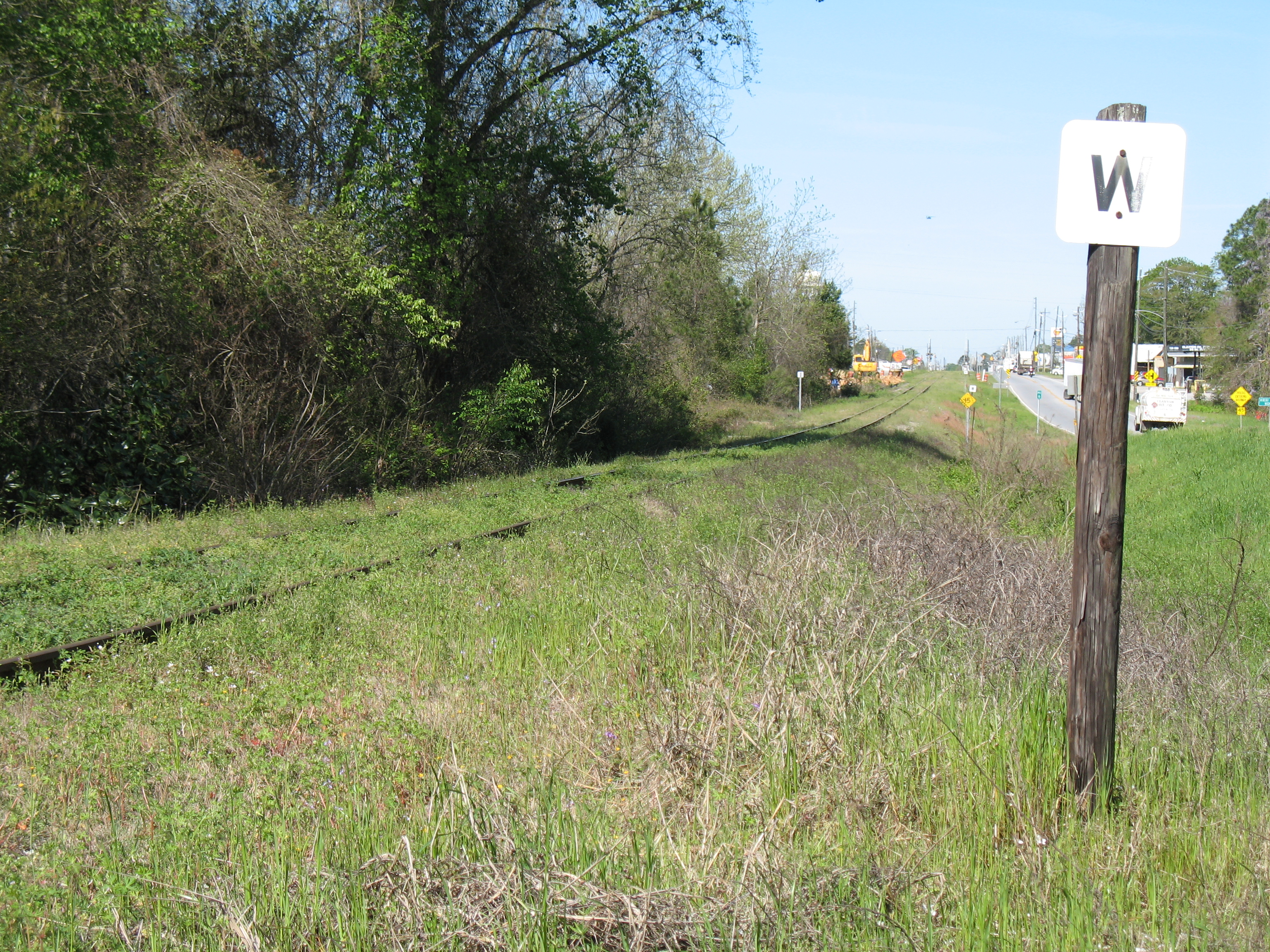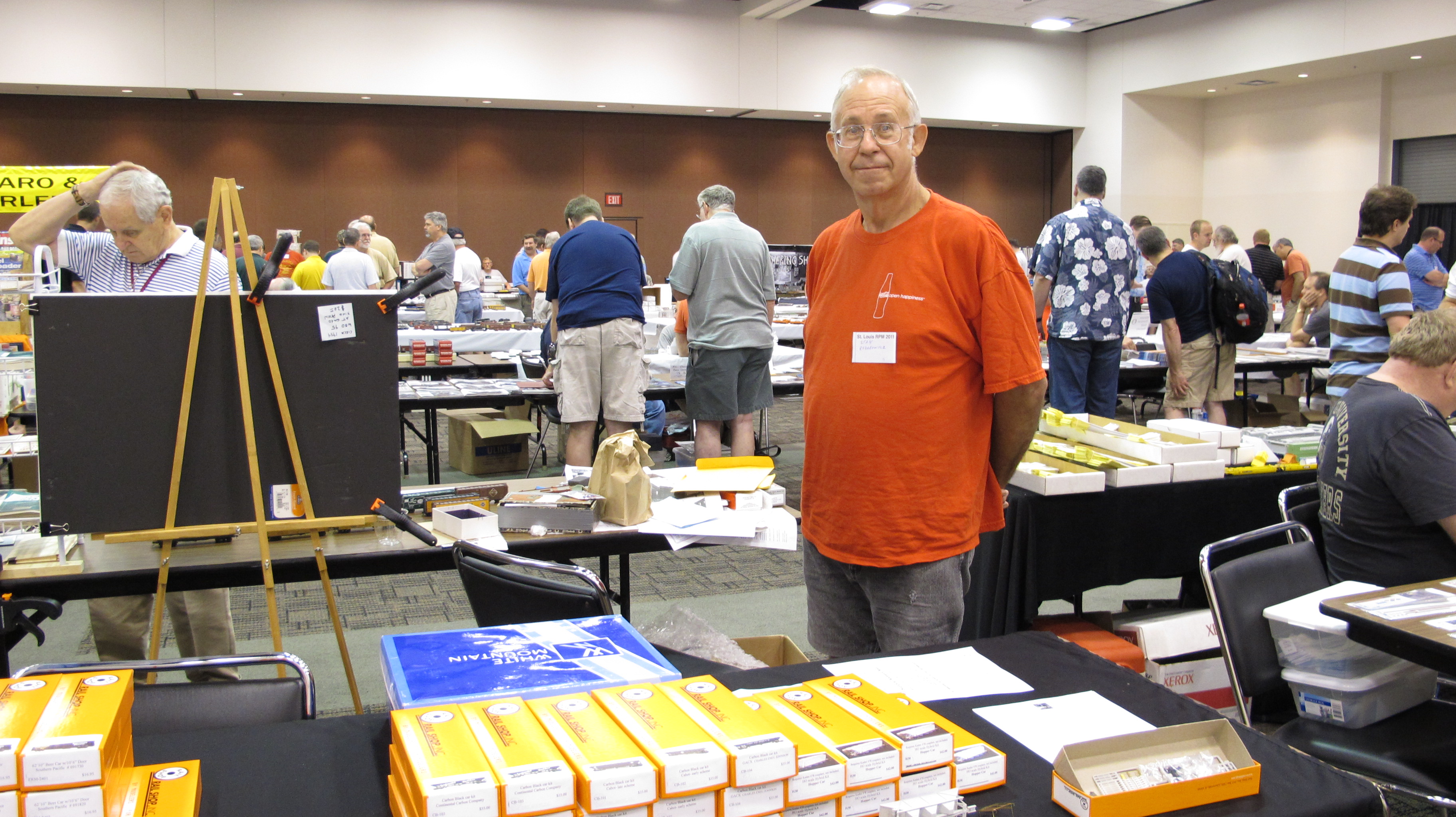
Back in February 2020, just about the time people in the West started talking about something called COVID-19, I began an unusual box car rebuilding project that took eight months to complete.
The project was the complete rebuilding of an old Model Die Casting shake-the-box MoPac auto car kit. The prototype photo above is from Joe Collias’ photo collection, courtesy Ed Hawkins. The photo has an interesting story which I relate a little bit later.
These cars have always been among my favorites, and the introduction of a top-of-the-line decal set by Ted Culotta of Speedwitch Media, specifically made for this model, sealed the deal. I ordered the decals, and then ordered a used MDC car on eBay for five bucks . I started the project as soon as the model arrived here in Germany–that was way back in February.
Here’s the carbody shell, below, lined up with a prototype photo from the Speedwitch decal set.

While I was waiting for the parts to arrive, I reached out to my old buddy Ed Hawkins–THE source on Missouri Pacific freight cars–and got some good information on the prototype cars. Here’s Ed:
Hi John,
From 1925 thru 1929 MoPac purchased a total of 1,300 – 50’-6” single-sheathed auto cars. All 1,300 cars came with SREM radial roofs. There were differences in other variants such as the original inside height, door openings, door types, and end types. Of the 1,300 total, 200 cars came with end doors and 1,100 without.
The first 450 were carbon copies built in 1925-1926 with 10’-0” IH, 3-section Murphy ends with a 5-5-6 (top to bottom) inward-facing corrugation pattern, 10-foot side door openings & wood doors. Over time a substantial number of these cars received a raised roof and were renumbered.
a. 85000-85199, 200 cars built ca. 4-25, ACF lot 9936 (no end doors).
b. 85200-85449, 250 cars built ca. 3-26, ACF lot 102 (no end doors).
The balance of 850 cars were built in 1927-1929 with 3-section Dreadnaught ends, 200 cars of which had Dreadnaught “A” end doors. A substantial number of these cars with Dreadnaught ends received a raised roof, widened door openings, and were renumbered.
c. MP 85450-85949, 500 cars built ca. 6-27, ACF lot 399, 10’-0” IH, 11’ door openings (no end doors).
d. MP 89000-89069 (70), I-GN 14251-14265 (15), StLB&M 20551-20565 (15): 100 cars built 11-28, ACF lot 723, 10’-2” IH, 12’-0” door openings, wood doors (end doors).
e. MP 86000-86149, 150 cars built MVC (job no. unknown), 10’-2” IH, 12’-0″ door openings, Youngstown doors, Ajax power hand brakes (no end doors).
f. MP 89070-89169, 100 cars built MVC (job no. unknown), 10’-2” IH, 12’-0″ door openings, Youngstown doors, Ajax power hand brakes (end doors).
You know, Charlie did an article on these cars in Mainline Modeler some years ago. Here’s a copy [included below].
From the above you can select the closest model. Do you still believe that the 86000-86149 series is best?
Ed
Below. An excerpt from the Mainline Modeler article sent by Ed. Charlie’s article helped a lot with my build.

I began the build by cutting off all the cast-on ladders and grab irons. The carbody loosely matches the MP 86000-86149 series cars except the model has a lumber door on the A end. I compromised and did not scrape off the lumber door. I did carefully remove the ladders and grab irons, and also sanded smooth the diagonal end braces as well. All that cutting and sanding took a long time—10-15 minutes here and there over a period of about two months.

Once everything was cut off I sandblasted the entire model clean, and then began the detail process. Adding the detail parts back on the car was pretty simple, as I just had to add some grab irons, ladders, sill steps, uncoupling devices (“cut bars”), a replacement running board made from Evergreen styrene strip, and a few other parts. Even so, it took a month or two to get all those detail parts added.
Fitting doors was a problem. First I tried using the kit-supplied doors but they turned out to be too crude for my liking. Andy Carlson coached me through a few attempts at kitbashing doors and kindly sent me some parts to fix all my screw-ups, but I still couldn’t finish doors to my satisfaction. Tichy doors were close but didn’t quite fit either. Finally I cut up a dozen Intermountain 10-foot, 6-inch Youngstown doors and that did the trick. The only problem was the door opening was too wide for the Intermountain doors, so I had to model the car with the doors unlocked. The placard boards are from National Scale Car Co.
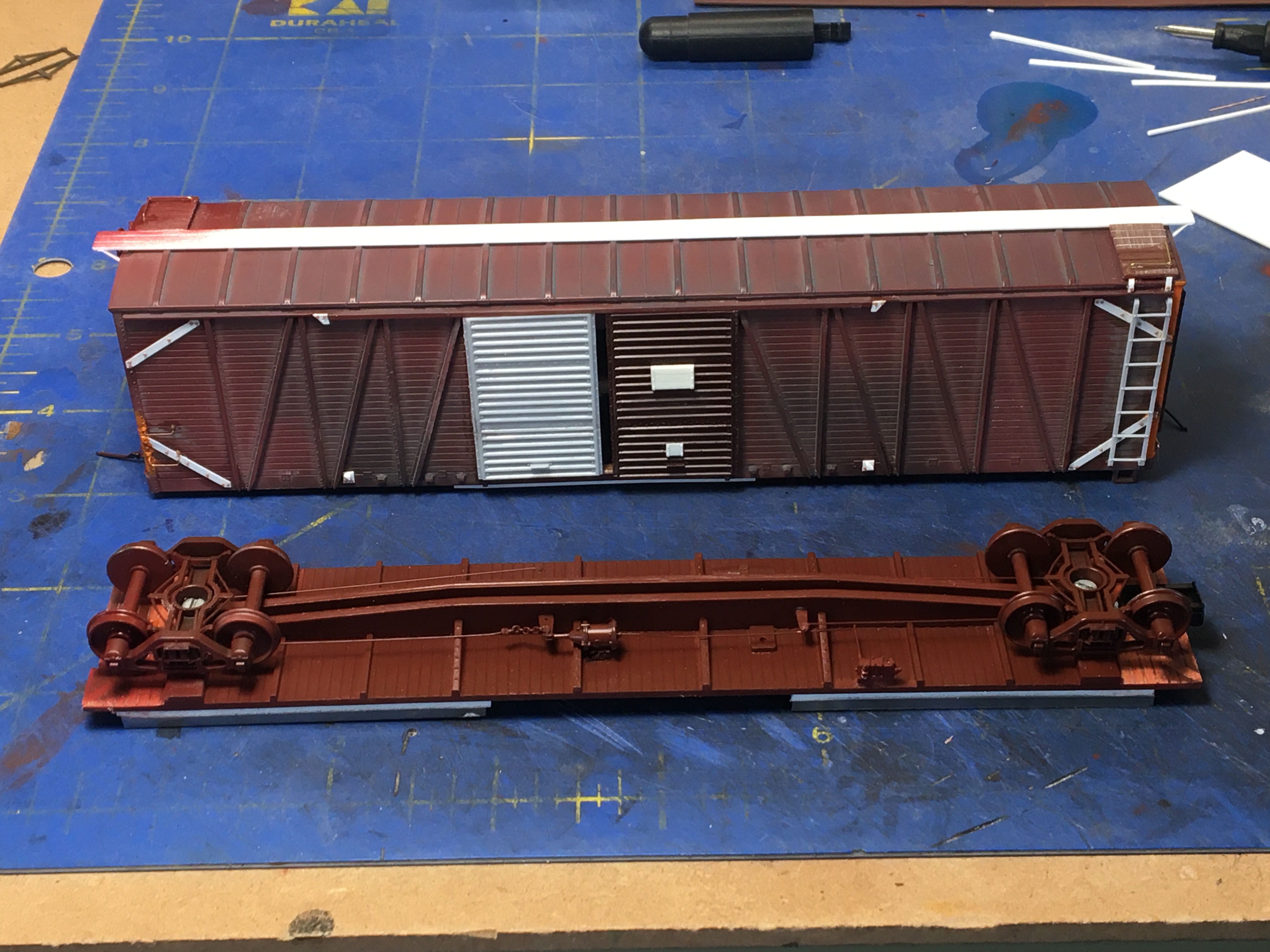
I sandblasted the car again lightly and then added a whole bunch of Tichy .020 rivets and Tichy 1-7/8-inch nut-bolt-washer castings, all in the appropriate places. I probably added about 150 rivets and nbw castings.
Detailing the underframe, by the way, was simple. I replaced the kit-supplied brake gear with parts from Cal Scale, and added Tahoe trucks with semi-scale wheel sets, then painted the underframe and trucks black per the prototype.
Below. Here’s another view of the car ready for painting. I first shot the B end to see how the model looked after all the scraping and sandblasting. It looked alright so I continued the project.

Once the car was completely detailed I sandblasted it clean again, then painted it with Tru Color MP Box Car Red (TCP-139). Man, that is a beautiful color. So rich.
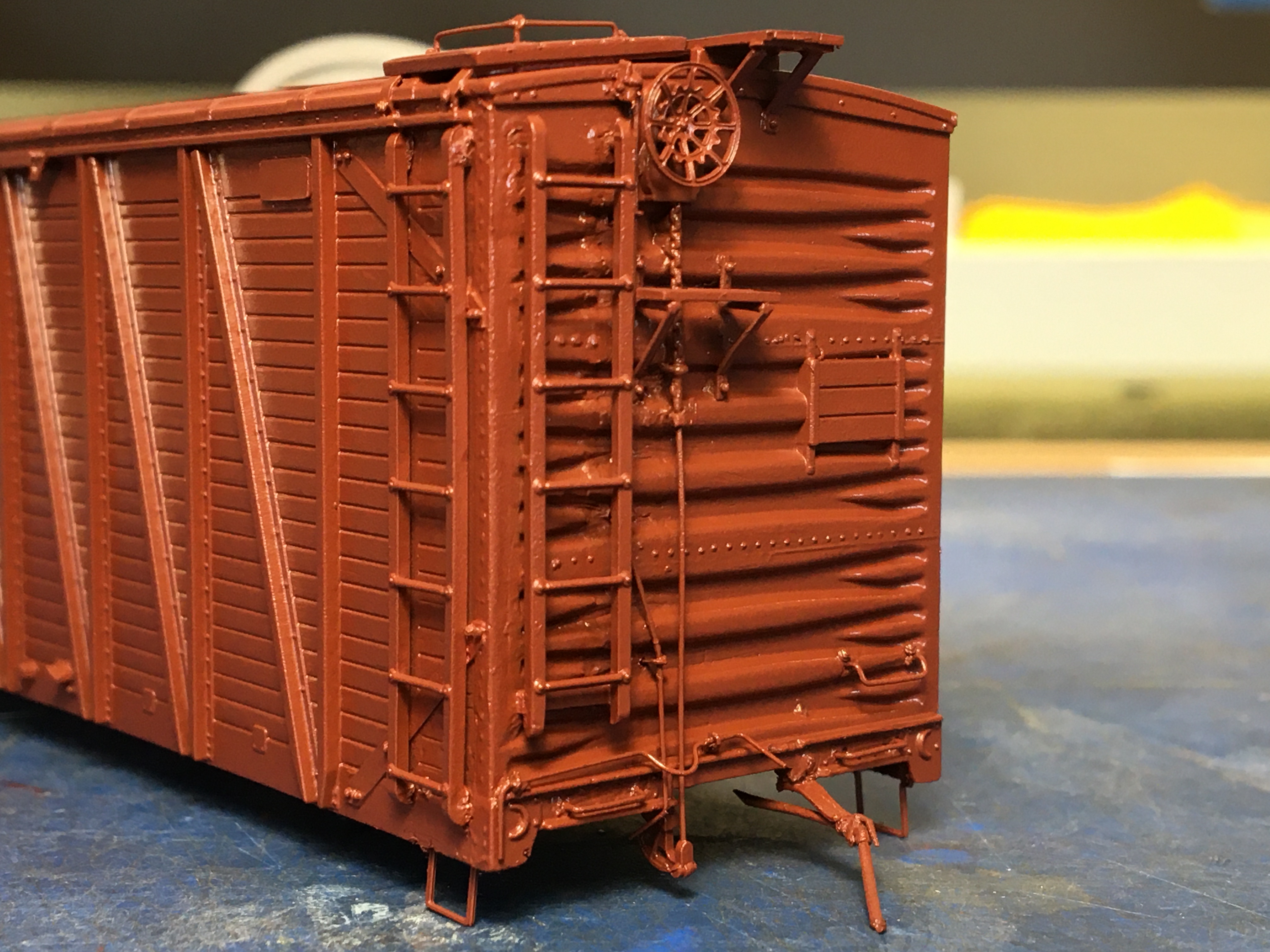
Ed and I got into another discussion about the car colors. Ed wrote, Depending on the time period your model will represent, MoPac’s box cars changed shades quite significantly. During the 1930s to about 1942 or so they were a dark brown with a flat finish virtually identical to the 1931-1944 Santa Fe Mineral Brown. This is determined by comparing several actual ACF paint samples from their bill of materials documents.
In the 1945-1948 period, both MoPac and Santa Fe moved to a medium red-brown shade as well as the paint having a medium-gloss sheen. This is confirmed by comparing ACF paint samples of Santa Fe cars circa 1945-1949 to MoPac paint samples from 1945 with a medium red-brown hue. This is a close match to the old Floquil #RR74 (when sold in the square bottles). You may be too young to remember them!
By the early 1950s, MoPac began painting their box cars with more red than previous. A 1956 Bowles Color Drift Card shows the color to be an near-perfect match of the color used by Branchline Trains on their MoPac 40’ steel box cars built during the 1950s including the special run of 12 models offered by the MPHS to the members in 2003.

I decaled the model with the beautiful Speedwitch decal set. That took another week or so. Once the decals were set I shot the model with Testors Dullcote, and then shot the model with a second coat of Dullcote missed with about 10% TCP-139 to blend the decals and original paint together.
Below. Here’s a photo of the decals applied, prior to Dullcote. The ladders I chose to use, incidentally, are the old Detail Associates ladders. Another good choice would’ve been ladder from an Intermountain 10-6 box car but I didn’t have any spares on hand.

After decaling and Dullote I added chalk marks using a white artist’s pencil and sealed them with a final light coat of Dullcote. I also added some chalk marks using a medium gray pencil, and I found that I like that effect a lot. The gray chalk marks look a little older, or perhaps weathered.
I added weathering using a variety of methods. I added a little AIM weather powder (Delta Dirt on the carbody and Soot Black on the roof), a little airbrushed weathering (Testors Dark Tan), and a little highlighting (using a variety of lighter and darker reds and browns to accentuate the finish. I used some red and brown artist’s pencils to accentuate the wood sides and a few other standout parts.

I’m VERY happy with how the model turned out. Even though the doors are open, everything still looks alright.

Now here’s the funny part. After the model was completed I discovered that I numbered the model wrong on one side of the car. I applied the correct 86000-series number to the ends and one side, but without thinking applied an 89000 car number on one of the sides. I think I did that because I was using a photo of an 89000-series car as my decaling guide, and I think I simply inverted the 6 for a 9 and that was that. I blame the beer. I may try to fix it someday, but someday isn’t today.
I also need to change those trucks, since the 86000 series had spring plankless trucks. They’re on order.
By the way, did you know Frisco had almost identical cars? I’ve got a photo and as soon as I can get permission from the owner, I’ll post it here.
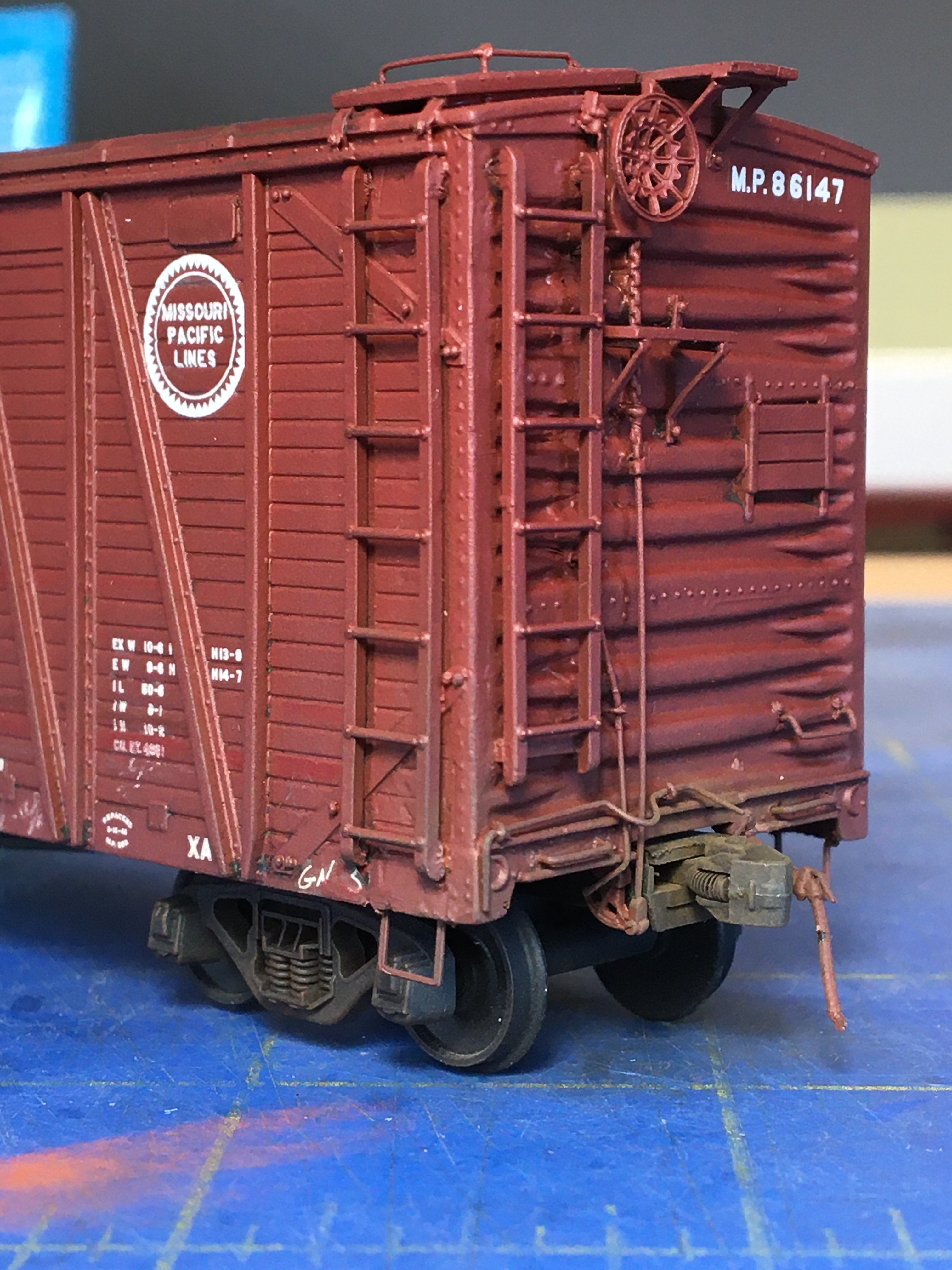
I mentioned earlier that Ed had an interesting story about the cover photo. Ed wrote, Not too long ago I purchased that photo from the church that Marjorie Collias donated Joe’s photo collection to.
The photo was taken by the Mount Vernon Car Manufacturing Co. It’s a “strange” builder photo; while it’s on canvas-backed 8×10 photo paper, the image itself is rather distant being only about 7” wide and therefore only taking up about 1/3 of the total area. My scan was 100% (full-size) at 600 dpi so that you could see all of the details the image has to offer.
Joe obtained the original photo from the Missouri Pacific Public Relations department. I’m fortunate to now be the proud owner.
Speaking of Joe Collias, here’s a photo of Joe, on the left, and Pat Wider, on the right, at St. Louis RPM in 2011. Joe of course was one of the most famous rail photographers in the Midwest and has many classic railroad books to his credit. Joe was also an accomplished modeler in the pre-internet era. He was well-known for scratchbuilding and kit-bashing in brass. Pat was the driving force behind the Railroad Prototype Cyclopedia series of books.
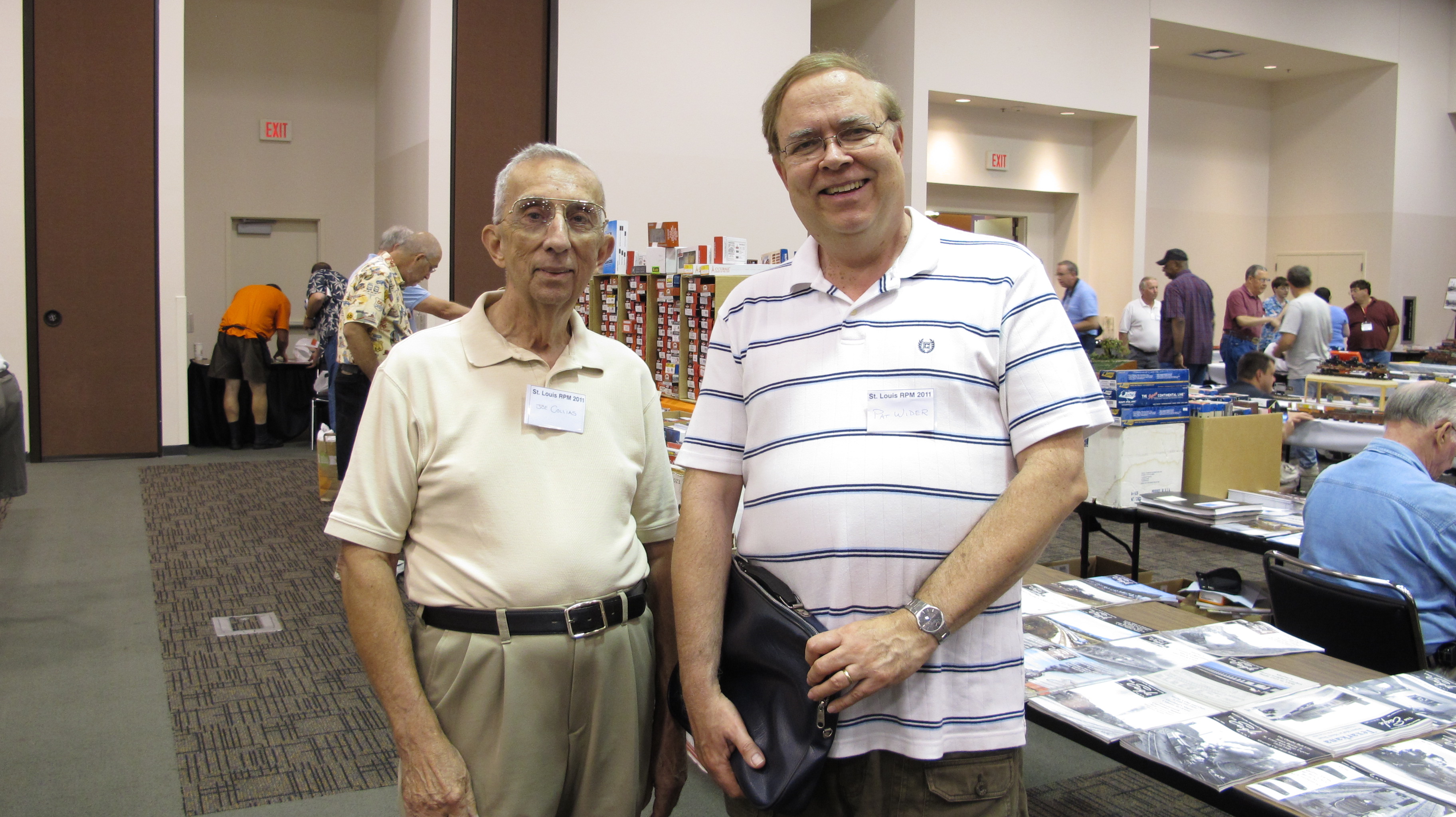
And here, below, is the lovely Marjorie Collias from St. Louis RPM that same year. Marjorie would sit with Joe and sell photos, and add a whole lot of class to the meet. Every time I saw them together, I’d ask her how she could put up with a cantankerous old timer like Joe for so many years. Of course Joe was right there. We always had a good laugh.

Ed, I can’t thank you enough for your help with this project and so many others. You are a fine man.
And Joe, you are missed, brother! – John G
























